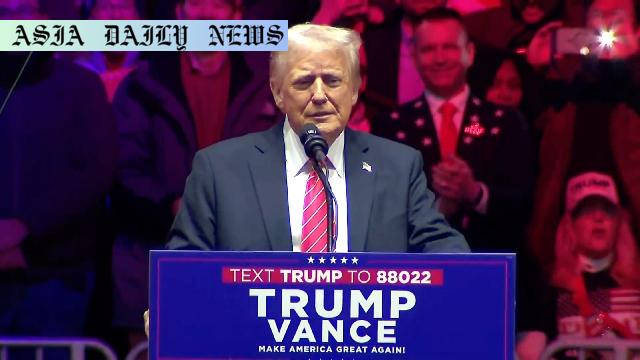Donald Trump set to be sworn in as the 47th US president amid cold weather, following his vow to bring transformative policy changes.
- Donald Trump will be inaugurated as the 47th US president.
- The ceremony is moved indoors due to severe weather in Washington.
- Trump promises transformative changes and swift actions as president.
- Public opinion remains divided over Trump’s leadership.
- He aims to reverse Biden administration policies on immigration, tariffs, and energy.

US Presidential Inauguration Ceremony Begins in Washington
The United States is set to witness a significant transition in leadership as Donald Trump prepares to take the oath of office as the 47th president. The inauguration ceremony, scheduled for Monday at noon, will be conducted in the Capitol building’s rotunda due to inclement weather conditions marked by severe cold and strong winds in Washington, D.C.
Traditionally held outdoors, this year’s inauguration ceremony has been adjusted to ensure safety and comfort in the face of extreme weather. Despite the chilly conditions, the event is expected to gather the attention of millions across the nation and globally as Trump takes the helm of the country for his second term in office.
The president-elect hosted a rally in Washington on Sunday to connect with his supporters. Speaking to an enthusiastic crowd, Trump stressed his commitment to fulfilling the expectations of those who endorsed his vision for America. In his address, he promised to act swiftly and effectively to address significant national challenges, emphasizing transformative changes in key policy areas like immigration, tariffs, and energy.
Trump signaled a focus on executive action as a means of implementing his agenda. “You’re going to see executive orders that are going to make you extremely happy,” he stated to an approving audience, highlighting his intention to bypass legislative roadblocks and accelerate the execution of his proposed policies.
In line with tradition, Donald Trump will meet with outgoing President Joe Biden at the White House on Monday morning before heading to the Capitol for the swearing-in ceremony. The peaceful transition of power between the incoming and outgoing administrations remains a cornerstone of American democracy.
As Trump assumes office, public opinion continues to be polarized. Polls from major networks like CNN and Fox News reveal a close split between favorable and unfavorable views of the new president. This division underscores the challenges and opportunities that lie ahead for Trump as he embarks on his presidency.
Observers note that Trump’s leadership will involve navigating a politically charged environment. His policies are expected to diverge sharply from those of his predecessor, Joe Biden. In particular, Trump’s approach to immigration reform, trade tariffs, and energy production is set to realign national priorities and impact America’s standing on the global stage.
Inaugurations signify more than just the beginning of a new administration; they represent a moment of renewal and the potential for change. Trump’s accession to the presidency underscores a complex political dynamic, with his promise to tackle pressing national challenges with “historic speed and strength.”
The road ahead will test Trump’s ability to unite the country, deliver on his commitments, and address economic, social, and environmental challenges within a deeply divided political framework. As the world watches, the inauguration sets the stage for an era of unprecedented change and action under Trump’s leadership.



Commentary
The inauguration of Donald Trump as the 47th president of the United States marks a pivotal moment in American politics, as it brings with it a promise of significant policy shifts. Regardless of one’s opinion about Trump, his leadership style is undeniably distinct and focused on swift action, especially evident in his assurance to implement transformative policies through executive orders. This approach, while efficient in implementing change, raises critical questions about inclusivity and bipartisan collaboration within the country’s governance framework.
One of the most striking aspects of this inauguration is the indoor setting necessitated by Washington’s severe weather conditions. This logistical adaptation highlights the resilience and determination to uphold the traditions of a peaceful transfer of power, irrespective of external challenges. It reflects the symbolic nature of inaugurations, standing as markers of national unity and democratic continuity, even amid division and adversity.
Trump’s bold claims and commitments during his rally have, once again, ignited fervor among his supporters. His focus on immediate results and sweeping policy changes carries a sense of urgency, resonating with those who feel left behind by previous administrations. From his stance on immigration to his plans for reshaping energy policies, Trump’s agenda is ambitious and transformative. Yet, it remains to be seen how these goals will be realized and whether they will bridge or deepen the nation’s divides.
Public opinion remains deeply polarized, with many Americans both hopeful and skeptical as Trump takes office. His administration must navigate this landscape delicately, recognizing the need for compromise and dialogue in addressing the country’s diverse challenges. The emphasis on executive orders raises concerns about bypassing traditional legislative processes, which are crucial pillars of democracy and accountability.
As Trump prepares to meet with Joe Biden and officially assume office, it is essential to reflect on the broader context of this transition. Inaugurations are not just about one individual or party; they are about the enduring institutions that uphold democracy. Trump’s second term provides an opportunity to tackle pressing national issues with renewed focus, but it also carries the weight of uniting a fractured populace and reinforcing the integrity of the country’s democratic foundations.
As spectators and citizens, it is our role to remain vigilant, informed, and engaged. It is through active participation and dialogue that the ideals of democracy can be strengthened, ensuring that leadership—regardless of ideological leanings—serves the best interests of the people it represents.